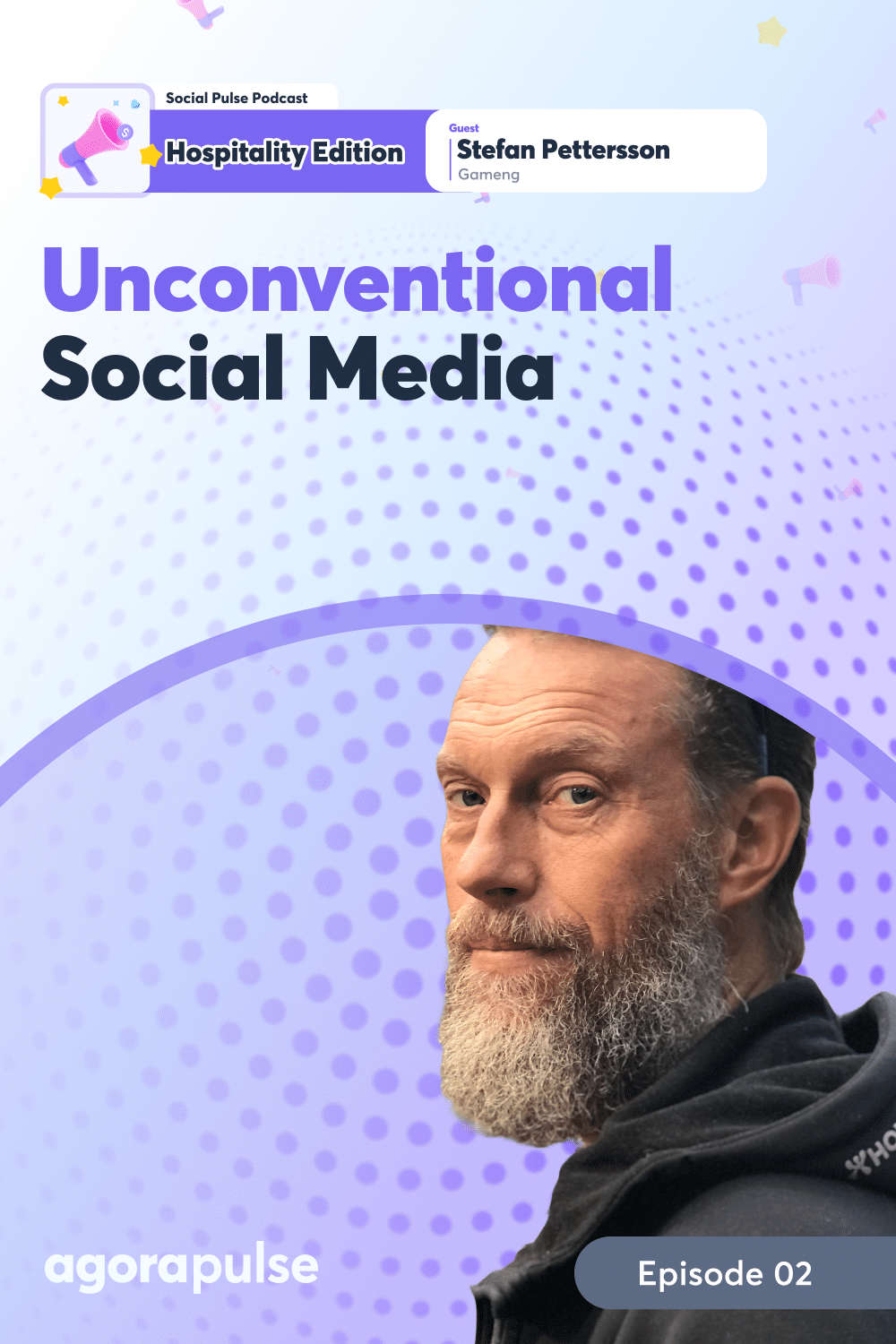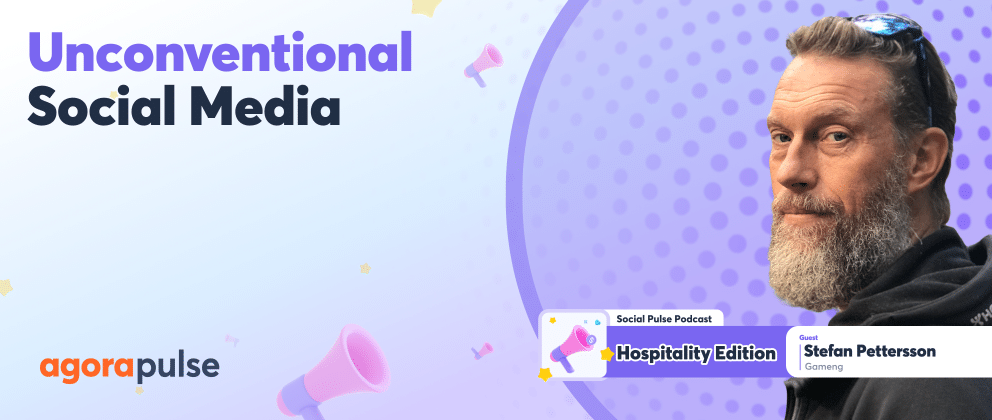Have you ever been frustrated by social media algorithms that seem to work against you? Struggled to capture your audience’s attention amidst a sea of similar content?
There’s a way to break free from these challenges to innovate and inspire your social media strategy through unconventional thinking. Our Social Pulse Podcast: Hospitality Edition guest Stefan Petterson joins Agorapulse’s Chief Storyteller Mike Allton. As the co-founder of Gameng a hub for rebellious yet purposeful innovations in sustainable tourism, Stefan challenges the status quo with what he calls “corkscrew thinking.”
Today, they will talk about how you can apply these radical principles to your own social media marketing efforts in the hospitality industry.
[Listen to the full episode below, or read along for the transcript of the Social Pulse: Hospitality Edition, powered by Agorapulse. Try it for free today.]
What Is Corkscrew Thinking?
Stefan Pettersson: First of all, we need to look back in history a little and corkscrew thinking—actually, we can say it was invented by Winston Churchill during World War II.
Churchill needed a plan to beat the Germans. And the thing was that it was like a straight line—you have an idea, and on the opposite side, they knew exactly what you should do. So it’s going to be only conflict because it was war.
So what he did was to assemble a lot of bright-minded people from different kinds of industry. And they started thinking, “How can we do what everyone knows we are going to do but in a way that they won’t see it coming?” That’s what it’s called. (There’s a movie you can watch called Operation Mincemeat, which is about this.)
What they did was create the persona of a dead soldier to carry out the mission. They included a letter with the dead soldier that said they were planning to fight elsewhere. They also invented other details, like a letter from a bank saying his account had been frozen due to insufficient funds and a love letter to his girlfriend in the UK. They let his body wash up on the shores of France. The letter was marked “Not to be read” because it was classified, but, of course, the Germans read it. When they saw the documents, they believed it was true.
“Corkscrew thinking is about focusing on the disruptors—identifying what’s next and what challenges we face in order to move forward. It asks questions like: What’s the first thing we need to break down as a problem? How do we take the next step?
Instead of thinking in a straight line, corkscrew thinking involves looking at issues from different angles and considering a variety of perspectives.”
For example, when working on a project for a destination or city, we invite a wide range of people: politicians (even though we know what they’re going to say), city governance, private enterprises, organizations, and local residents.
These different groups provide various perspectives on the same issue, allowing us to explore non-linear solutions.
Just like a corkscrew, we approach the problem from different angles to find a solution that is long-term and sustainable.
Mike Allton: I knew I liked you the moment you started talking about a historical reference. I do that all the time, and Operation Mincemeat, I think, is a great example, right? They were using misdirection, but they were thinking long-term, “What would the enemy do if we did this, what would they do if we did that instead? How do we get them to do what we would like them to do and position ourselves in a place of strength, right?” They wanted to attack Sicily and not have very many Germans there when they attacked, so they made the Germans think they were attacking someplace else and move their forces.
And that’s a great way to think around the problems instead of attacking social media by just posting more and posting more and hoping that you get the end results you want to get.
Outdated Social Media Practices
Let’s think about the issue: How can we approach social media? How can we approach marketing in general and get the results that we actually want by being creative in our thinking?
So we’re talking about social media specifically.
What are some traditional social media practices that you think are outdated— particularly in the context of hospitality marketing?
Stefan Pettersson: First of all, traditional methods like posting static content without any interactivity or personal connection with the audience feel outdated.
- In today’s world, with social media allowing direct, peer-to-peer communication, why stick to old-school methods that offer little return?
- Communication now is a two-way street, not like the days of using a megaphone to broadcast a one-way message.
- Because of this, it’s crucial to understand your audience—not just who they are, but how to engage them.
- You need to create a platform where communication is interactive and co-creative, where people can collaborate to get the value they’re looking for.
And with new technologies like AI and ChatGPT, everyone can create content. It might be good or bad, but it’s accessible, easy, and affordable for anyone, including small and mid-sized companies. Now, these businesses have the power to do things they couldn’t do before.
I think that’s the future.
Mike Allton: That makes a lot of sense. I was talking with Andy Crestodina on my AI podcast, and he was dubbing AI “average intelligence” because when businesses and marketers go to AI, if they don’t spend a lot of time working with it, they’re just going to get the average of responses, mediocre responses, and it just creates this sea of content that we talked about at the outset.
Individual businesses need to stand out. They need to develop a community. They need to have dynamic content.
Corkscrew Success Story
Could you share an example of a rebellious social media campaign that broke away from some of these social norms and succeeded?
Stefan Pettersson: I have a great example of a campaign—maybe not the best, but it’s really impressive. It took place a couple of years ago, back in 2016. It was run by Visit Sweden, a marketing agency for the country where I’m from: Sweden.
The campaign was called The Swedish Number. The idea was simple but powerful: They told Swedish residents that they could be part of the campaign by adding their profiles.
Then the Swedish Number was launched worldwide, allowing anyone to call and be randomly connected to a Swede who could answer questions about the country. (There’s a great video about it—I can send you the link if you’d like.)
One of the funniest moments was when someone called and got connected to the Swedish Prime Minister. The caller thought it was a joke at first, but it wasn’t!
The campaign was a brilliant way to market Sweden, highlighting freedom of speech, safety, and how welcoming the country is for travelers.
The campaign not only increased international engagement but also boosted participation from Swedes themselves. It created authentic, personal connections between Sweden and potential visitors, which I think is a fantastic example of innovative marketing.
Mike Allton: Yeah. That’s amazing ’cause you’re not only having marketing materials, and you’re not only having basically customer support, right? Where you’ve got people who can call in and get answers to their questions, but it was activating real-life people in Sweden who were basically elevating their national pride. I could see every country in the world using a similar campaign like that and getting their own real people to talk about their experience living there.
Stefan Pettersson: There were 180,000 calls made to the Swedish Number—that’s crazy! It was so much fun because you never knew who you’d get connected to. You’d just pick up the phone and suddenly be talking to someone from a different part of the world.
Mike Allton: Do you have any insight as to how they actually came up with the idea for that campaign?
Stefan Pettersson: It all started about a year before the Swedish Number campaign when they ran another initiative with the Twitter account for Sweden. They handed it over to different people, like “Now it’s your turn,” and then later passed it on to someone else. It was a small-scale test, and then they leveled up to this larger campaign.
As for the technique they used, I’m not sure, but it was so funny and a bit crazy. The whole idea was just so unique and engaging.
Mike Allton: For the social media managers listening [and reading!], what Stefan’s talking about is letting your users hijack your social media account for an hour or a day and have a live AMA about what it’s like to be a resident or an attendee or a customer of your hospitality business, whatever that might look like.
Finding Opportunities to Disrupt
How do you think that social media managers in this industry can identify opportunities that could disrupt or innovate some of their current strategies?
Stefan Pettersson: Of course, they can.
They need to analyze and not only focus on their own customers but take a more behavioristic approach. You need to study different trends, keep an eye on competitors, and cross-examine other industries as well.
For instance, if you want to reach a certain target audience, that audience is likely interested in things beyond what you offer. This can give you valuable clues about how to reach them and communicate in a way that resonates.
I think this approach is similar to tribal marketing, where you try to act as your audience would: speaking their language, observing their habits, and understanding their interests. Shorter messages, quick video clips, or user-generated content are all important because—if you think about how people consume media today—they’re likely to lose interest in less than three seconds and move on.
What do you think, Mike? Is that accurate?
Mike Allton: Yeah! In fact, I love what you’re talking about.
I’m going to share a tool recommendation with all of you—SparkToro. SparkToro is Rand Fishkin’s baby. He created Moz, and then he went on to found SparkToro. You can enter a couple of things that you know about your audience. They’re in Seattle, and they like hiking, whatever the case might be.
And it will help you identify: What are the other interests that the audience has a nice little Venn diagram cross-section of? To your point, Stefan, what are the media that they’re consuming? Are there particular social channels? Are there newsletters, podcasts, or listening to YouTube videos and channels that they’re watching?
You can learn so much about the things that you could be talking to your audience about and which channels to be talking to those audiences for. So, that would be a great tool for you guys to kind of disrupt your own unconventional thinking.
The Challenges of Being Unconventional
But if someone’s going to start doing some of this kind of stuff, Stefan, and then thinking unconventionally about how they approach social media …
What kinds of challenges do you think that they’re going to run into, and how do they overcome them?
Stefan Pettersson: I believe you should ask this because, as we mentioned earlier with the example of the Swedish Number, there were a lot of people asking, “How can we do that? How can we let the audience or anyone else take control of our brand?”
Of course, there are challenges—whether it’s dealing with government regulations for a destination or resistance from management at your job, there are always risks when you try to be experimental or think in a nonlinear way.
But if you bring everyone together and involve them in the creative process from the start, you can help build courage across the team. When people feel like they’re part of this journey, it leads to success. And, yes, things like thorough analysis, audits, and smaller, more agile sprints where you can test ideas are essential. They help build confidence within the group and the company as a whole.
Start small, test ideas, but above all, get to know your audience.
That’s the key to everything.
[Don’t miss brand NEW episodes of Social Pulse Podcast: Hospitality Edition, where we’re digging into the challenges, successes, and stories of social media and community professionals in the industry, just like you.
Subscribe to gain valuable insights that you’ll be able to apply to your own work and social presence from each and every episode.]
Mike Allton: I think that’s great advice. ‘Cause I think those of you listening [and reading!], probably the most likely challenge you’re going to face is getting buy-in from your direct supervisor or manager to do something that’s probably going to sound crazy, and they’re going to say something like, “Well, we’ve never done anything like that before.”
And so Stefan’s advice is perfect: Start small, start with a pilot program. See if you can MVP that idea, that plan, and then once you see some success, then you can roll out the larger idea.
One of the things that I love about that example you shared—Visit Sweden—was that it obviously is going to build a community. It’s going to build a community of actual Swedish people and also the people who are thinking about coming to Sweden.
How to Build Community
So, if we go at a higher level, how do you suggest building a genuine, impactful engagement strategy that empowers followers and builds community like [Visit Sweden] did?
Stefan Pettersson: When it comes to AI and these various tools, the first thing you need is a communication strategy—not a strategy for AI or Facebook specifically, but an overarching plan for how you communicate.
- Think about what you want your audience to feel, how you want them to engage, and how you can bring their needs and their search for value into alignment with your company’s mission.
Understanding your audience is key.
- There are many tools out there, and they’re becoming more affordable.
- Almost everyone is using ChatGPT or other AI tools, even if they don’t mention it.
- These tools can help refine campaigns and monitor engagement, making them valuable resources.
- But remember, your customers and clients are likely using these tools, too.
- So, it’s essential to step up and guide them, helping them see the unique value you bring.
That’s what makes the difference.
Mike Allton: I think you’re right. AI is not a strategy. It’s no more than we would have a strategy for using technology that you need to think about how you’re going to use it.
Using AI for Social
What role do you think AI plays specifically when it comes to creating social media tactics?
Stefan Pettersson: Unfortunately, if you scroll through LinkedIn right now, you’ll notice so many posts are filled with smiley emojis and have a certain polished tone. It’s become obvious that a lot of corporate and individual posts are written by ChatGPT. There’s just so much text in these posts, and it can feel a bit overwhelming.
If you want to stand out, try creating your own post first. Then run it through an AI tool for grammar and maybe a touch of polish, but don’t rely on AI to write your post from beginning to end. Be part of the process; add your unique touch.
“Of course, AI is a powerful tool—it can accomplish tasks in seconds that used to take weeks just a few years ago. For those in the creative industry, it’s definitely a big help.
But keeping your own voice in it? That’s very, very important.”
Mike Allton: And you’re right, of course, about LinkedIn.
For a while, they’ve had these collaborative articles that anybody could look at the article, the topic, some of the questions, and then contribute their thoughts and 750 characters or less. And if you did that enough with the same topic, then you’d get a nice little gold badge on your profile that said you were a top voice in whatever topic, top voice, AI, top voice, social media, and whatnot.
And they just announced today that they’re actually discontinuing that completely because, to your point, there were probably too many AI-generated contributions, and that badge was automatic simply based on the volume of contributions.
There was no real check as to the quality of the content that you were creating. And I appreciate your point about how AI is helping us do things faster. I mean, I’ve told many people one of the things that they can use AI.
I think the best for it’s to have a conversation about their strategy and help them think through how they want to approach social media, and how they should be talking to the customers, validate and vet that, of course, but it’s free consultant and strategist that you can tap to learn how to do anything to have that great conversation.
Unconventional Tools/Platforms to Use
Do you have any specific tools or platforms that you enjoy that—let’s go back to just this idea in general—disrupt your social media strategies? Any particular tools or platforms that can help our social media audience with that idea?
Stefan Pettersson: This isn’t going to be anything groundbreaking, but I wanted to talk a bit about ChatGPT—specifically the version you pay for 4.0 or however you call it. It’s been really helpful.
- Canva. There are also tools like Canva, which is great if you don’t want to spend too much. It’s useful for graphic design and making those quick video shorts you can send out.
- Hootsuite. And then there’s Hootsuite for planning and scheduling. Honestly, it’s like a jungle of free tools you can try, so you’ve got to decide what’s actually useful.
- Fireflies. For example, I use Fireflies—it’s great in meetings because it records, gives you a script, and even suggests follow-up topics. It’s really smart like that.
- Agorapulse. And, of course, there’s Agorapulse—you could say a lot about that too, right?
Mike Allton: Right. So, and then I’ll just add a tip here if you’re working with a large language model like ChatGPT or Claude or Gemini, and you’re trying to come up with a social media strategy.
- One of the cool things that you can do with AI is keep asking it the same question over and over and over again. So you get more and more on average responses. Like, if you ask ChatGPT, “What are 10 things that I could post to our social media channels next month?” And you already told ChatGPT who you are as a business and who you’re trying to serve. It’ll give you 10 ideas that, like I said before, they’re the average. So you ask it for 10 more, and you ask it for 10 more, and you tell it, “Be creative, think outside the box. What else can I do?” And it’ll give you some really, really interesting ideas.
- And the good part is, which I’ve said before, it won’t get annoyed at you. (If you asked me the same question three times, I’m going to start to get annoyed because I don’t have patience for that.) AI will say, “Absolutely, Stefan, let me give you 10 more ideas!” And it’s fantastic for that kind of brainstorming.
Stefan Pettersson: Let me know if you’re open to one more example.
I have a small one that’s a bit different but meaningful:
- So, in Sweden, the Church noticed fewer people visiting graves during Halloween, which is a time when people usually light candles to remember loved ones because people move and aren’t always near their hometowns, fewer are coming in person. So, they created a digital way for people to light a candle from afar. At the cemetery, there was a special tree where LED candles would light up as people lit them online. This became a channel for connection, and it wasn’t just about the lights—priests and others were there to chat with people about loss, love, and life. It’s a beautiful example of how digital solutions can create real, meaningful connections. The church’s goal was to bring comfort and safety, and I think this was a brilliant way to do that.
Mike Allton: It’s a great story.
We talked about something very similar in a previous episode with Potters Resorts about how they used social media and Agorapulse in particular, to continue to foster and grow their online community with local families in Southeast England during the pandemic when the resort had to be closed. So they had no physical open presence like all of us during the pandemic, but they were still able to keep that community thriving so that when things did loosen up, not only did they reopen. They opened a second location and they went all-inclusive in the pandemic with so many other businesses closing down. So it’s a terrific story. Folks go back and listen to that. We’ll have that in the show notes below.
Measuring Success
One of the questions I think a lot of people have in mind is if they’re thinking about these kinds of unconventional campaigns and approaches to social media, how do they measure success? How do they know that these campaigns are working? How do they know that it’s having any kind of impact on the business?
Stefan Pettersson: I think guerrilla marketing primarily focuses on brand engagement rather than just selling a single product. It’s all about how to build recognition for your brand. To gauge the effectiveness of your efforts, you need to measure key metrics like how many people are engaging with your campaign, communicating through it, and ultimately taking action.
The first step in a guerrilla marketing campaign is to create a community—a group of people who can become ambassadors for your brand. Once you have this community, it’s essential to develop a strategy for engaging with them and co-creating the next steps together. This engagement is crucial, as it helps spread your messages and generates leads.
Combining your digital presence with face-to-face interactions can be particularly effective. Nowadays, it’s not enough to solely talk about your product; consumers are bombarded with sales pitches. They are looking for authentic connections. If your marketing campaigns facilitate communication and foster a sense of community, you can gain valuable insights into their needs and challenges. This approach aligns with a lean management model, where you actively ask your audience about their values and how you can help them.
Don’t forget to find the Social Pulse Podcast: Hospitality Edition on Apple, and drop us a review. We’d love to know what you think. Don’t miss other editions of the Social Pulse Podcast like the Retail Edition, Agency Edition, and B2B Edition.






